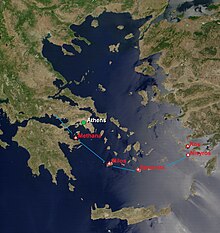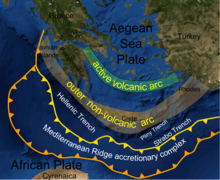210:, imagined a single great closure of Gondwana land on Eurasia, wrinkling up a mountain belt, the Altaides, that stretched from sea to sea. The simplicity and the name did not survive further scrutiny of the rocks. The mountain chain, subsequently the non-Suessian Alpides (he had his own Alpides, which amounted to the western Altaides), turned out to be the accumulation of orogenies in successive waves of advance. Not all the parallel chains derive from the same period or the same rocks. From the present, there is a virtual advance with a virtual resulting chain, but the chain is mainly a composite of successive chains.
27:
558:
39:
301:. It is customary to regard Tethys as gone, replaced by the Mesogean sea, plate, and orogeny, which were transitional to the Mediterranean. The Mesogean Plate is of Gondwana; that is, the predecessor of the African Plate. This plate, moving north as Gondwana approached the Alpine-Cimmerian-Eurasian Plate, dove under it in the ancestor of the
312:
in the Aegean has been a time of faulting to adjust to the current pressures. In the
Pliocene, the extension had been NE–SW causing "normal high angle faults trending NW–SE". In the Quaternary, the direction of extension changed to N-S with faults trending E–W. The type is predominantly strike-slip.
158:
compressing the region behind the arc. The extension deformed the region into its current configuration. First, the arc moved to the south and assumed its arcuate configuration. Second, the Aegean Sea opened behind the arc because the crust was thinned and weakened there. Third, magma broke through
217:". These are only terms of convenience to distinguish "Hellenic" from the mountains of other countries. They are accumulated mountain chains resulting from accumulated orogenies over time. Currently, three "waves", of orogenic activity can be distinguished, resulting in three "orogenic belts".
254:
began to separate from
Gondwana, closing Palaeo-Tethys in front of it and opening Neo-Tethys, or just plain Tethys, behind it. Cimmeria voyaged across the ocean to lodge against Eurasia, forming Cimmeria-Eurasia. The existing Cimmerides (named after the mountains of Crimea) account for the
305:. The result was the raising of the forearc and the "exhumation" of Peloponnesus and Crete. It began to migrate to the south by back-arc extension, jutting out into the Mesogean Sea and becoming arcuate. From there the geologic story becomes more familiar, being mentioned above.
80:
274:) the Tethys sea floor after depositing its Cimmerian passenger against Eurasia went on to dip beneath Cimmeria-Eurasia raising the inner (eastern) Hellenides (
357:, and Akyarlar. Of these, only Santorini, Kolumbo, and Nisyros have either erupted or shown any significant evidence of unrest during the past 100 years.
213:
The mountains of Greece, or
Hellenides (viewed as a singular collective thing) appear to have had a singular origin, superficially named "the
562:
321:
The active portion of the South Aegean
Volcanic Arc comprises a number of dormant and historically active volcanoes, including
263:. They cover the Black Sea region, the northern Aegean, and the eastern part of the Balkans. Their earliest date is the "pre-
282:
from the southwest, dipping under
Cimmeria-Eurasia and raising its margin into the Dinarides and outer Hellenides in the
521:
Mountrakis, D. (2005). "Tertiary and
Quaternary tectonics in Aegean area". In G. E. Vougioukalakis; M. Fytikas (eds.).
150:. It was not yet the sea, nor an arc, or at least not the one it is today, nor was there a chain of volcanoes. In the
532:
491:
166:
The extension is still ongoing. The current southern Aegean is one of the most rapidly deforming regions of the
593:
588:
73:
377:
170:
mountain belt. It is approximately 450 km long and 20 km to 40 km wide and runs from the
31:
The arc is shown by the green line. Along it are dozens of volcanic hot spots. A few are denoted in red.
504:
394:
583:
380:
was destroyed, with archaeological remains becoming well preserved under the volcanic ash.
248:
8:
578:
195:
256:
241:
233:
171:
159:
the thinned crust to form a second arc composed of a volcanic chain. And finally, the
538:
528:
487:
365:
361:
154:, the process of back-arc extension began, probably stimulated by pressure from the
237:
214:
160:
522:
471:
399:
369:
330:
322:
302:
127:
524:
The South Aegean Active
Volcanic Arc: Present Knowledge and Future Perspectives
279:
139:
26:
572:
542:
264:
155:
135:
95:
82:
389:
293:
The geologic stage was set for the latest orogenic zone, developing in the
207:
199:
119:
278:
range) and the
Anatolides. Phase 2 is the arrival of another terrane, the
167:
373:
309:
271:
147:
143:
131:
123:
404:
338:
287:
527:. Developments in Volcanology 7. Burlington, Vt.: Elsevier Science.
244:
in a new place, in this case across the north and east of
Gondwana.
298:
229:
225:
203:
151:
255:
northernmost chains of the
Alpides. Sometimes they are called the
350:
342:
294:
251:
221:
44:
557:
326:
283:
275:
183:
179:
175:
38:
43:
The volcanic arc is shown to the north of and parallel to the
354:
334:
48:
163:
broke away from Eurasia in the new fault zone to the north.
260:
236:. The break-up had been caused by shifting currents in the
108:
Those of Santorini, located at about the center of the arc.
364:
from this arc occurred on the island of Santorini in the
346:
482:
Jamie C. Woodward, ed. (2009). Chapter 15: "Volcanoes".
270:
Subsequent is a two-phase Alpine Orogeny. In phase 1 (
240:. A different location of an upwelling plume placed a
189:
228:(a continuous band of Eurasia and the Americas), and
206:
land for the purpose, and invented the -ides suffix,
16:Chain of volcanic islands in the South Aegean Sea
570:
514:
220:Preceding the first wave, the supercontinent,
232:(all the rest). Between the two of them was
484:The Physical Geography of the Mediterranean
370:catastrophic volcanic eruption of Santorini
520:
459:
447:
435:
423:
37:
25:
198:between Africa and Eurasia, who devised
316:
571:
190:Development of the Hellenic orogeny
13:
122:(chain of volcanoes) in the South
14:
605:
550:
556:
497:
476:
465:
453:
441:
429:
417:
1:
146:across what is now the North
515:General and cited references
410:
194:The original proponent of a
7:
486:. Oxford University Press.
383:
280:Adriatic, or Apulian, Plate
10:
610:
503:Hogan, C. Michael (2007).
224:, had already broken into
130:. The prior cause was the
563:South Aegean Volcanic Arc
507:. The Modern Antiquarian.
116:South Aegean Volcanic Arc
72:
64:
56:
36:
24:
20:South Aegean Volcanic Arc
395:Hellenic subduction zone
259:, after the land of the
360:One of the most noted
47:, which runs through
565:at Wikimedia Commons
317:Volcanoes of the arc
594:Volcanoes of Turkey
589:Volcanoes of Greece
196:convergent boundary
96:36.4167°N 25.4333°E
92: /
21:
362:volcanic eruptions
242:divergent boundary
234:Paleo-Tethys Ocean
172:Isthmus of Corinth
19:
561:Media related to
366:2nd millennium BC
182:peninsula on the
112:
111:
601:
560:
546:
508:
501:
495:
480:
474:
469:
463:
457:
451:
445:
439:
433:
427:
421:
215:Hellenic orogeny
184:Turkish mainland
168:Himalayan-Alpine
161:Aegean Sea Plate
107:
106:
104:
103:
102:
101:36.4167; 25.4333
97:
93:
90:
89:
88:
85:
68:South Aegean Sea
41:
29:
22:
18:
609:
608:
604:
603:
602:
600:
599:
598:
569:
568:
553:
535:
517:
512:
511:
502:
498:
481:
477:
470:
466:
460:Mountrakis 2005
458:
454:
448:Mountrakis 2005
446:
442:
436:Mountrakis 2005
434:
430:
424:Mountrakis 2005
422:
418:
413:
400:Minoan eruption
386:
319:
303:Hellenic Trench
192:
128:plate tectonics
100:
98:
94:
91:
86:
83:
81:
79:
78:
52:
32:
17:
12:
11:
5:
607:
597:
596:
591:
586:
581:
567:
566:
552:
551:External links
549:
548:
547:
533:
516:
513:
510:
509:
496:
475:
464:
452:
450:, pp. 3–7
440:
428:
415:
414:
412:
409:
408:
407:
402:
397:
392:
385:
382:
318:
315:
257:Hunic terranes
191:
188:
176:Greek mainland
142:, raising the
140:Eurasian Plate
110:
109:
76:
70:
69:
66:
62:
61:
60:Greece, Turkey
58:
54:
53:
42:
34:
33:
30:
15:
9:
6:
4:
3:
2:
606:
595:
592:
590:
587:
585:
584:Volcanic arcs
582:
580:
577:
576:
574:
564:
559:
555:
554:
544:
540:
536:
534:9780080457574
530:
526:
525:
519:
518:
506:
500:
493:
492:0-19-926803-7
489:
485:
479:
473:
468:
461:
456:
449:
444:
437:
432:
425:
420:
416:
406:
403:
401:
398:
396:
393:
391:
388:
387:
381:
379:
375:
371:
368:; during the
367:
363:
358:
356:
352:
348:
344:
340:
336:
332:
328:
324:
314:
311:
306:
304:
300:
296:
291:
289:
285:
281:
277:
273:
268:
266:
265:Late Jurassic
262:
258:
253:
250:
245:
243:
239:
235:
231:
227:
223:
218:
216:
211:
209:
205:
201:
197:
187:
185:
181:
177:
173:
169:
164:
162:
157:
156:Arabian Plate
153:
149:
145:
141:
137:
136:African Plate
133:
129:
125:
121:
117:
105:
77:
75:
71:
67:
63:
59:
55:
50:
46:
40:
35:
28:
23:
523:
499:
483:
478:
467:
455:
443:
431:
419:
390:Hellenic arc
359:
320:
307:
292:
269:
246:
219:
212:
208:Eduard Suess
200:Tethys Ocean
193:
165:
138:beneath the
120:volcanic arc
115:
113:
462:, p. 7
438:, p. 2
426:, p. 1
99: /
74:Coordinates
579:Aegean Sea
573:Categories
505:"Akrotiri"
374:Bronze Age
310:Quaternary
272:Cretaceous
148:Aegean Sea
144:Aegean arc
132:subduction
126:formed by
124:Aegean Sea
87:25°26′00″E
84:36°25′00″N
543:469386658
411:Citations
405:Santorini
339:Santorini
288:Oligocene
472:Akyarlar
384:See also
378:Akrotiri
376:city of
299:Pliocene
249:Cimmeria
230:Gondwana
226:Laurasia
204:Gondwana
152:Holocene
351:Nisyros
343:Kolumbo
331:Methana
323:Sousaki
295:Miocene
252:terrane
222:Pangaea
178:to the
174:on the
134:of the
57:Country
45:forearc
541:
531:
490:
372:, the
327:Aegina
284:Eocene
276:Pindus
238:mantle
180:Bodrum
65:Region
335:Milos
118:is a
49:Crete
539:OCLC
529:ISBN
488:ISBN
355:Yali
353:and
341:and
308:The
297:and
286:and
261:Huns
247:The
202:and
114:The
347:Kos
267:".
575::
537:.
349:,
345:,
337:,
333:,
329:,
325:,
290:.
186:.
545:.
494:.
51:.
Text is available under the Creative Commons Attribution-ShareAlike License. Additional terms may apply.

